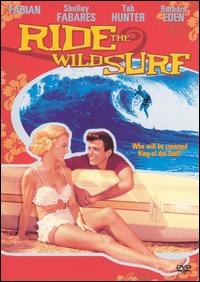
Surfing is a surface water sport in which an individual, a surfer, uses a board to ride on the forward section, or face, of a moving wave of water, which usually carries the surfer towards the shore. Waves suitable for surfing are primarily found on ocean shores, but can also be found as standing waves in the open ocean, in lakes, in rivers in the form of a tidal bore, or wave pools.

Waimea Bay is located in Haleiwa on the North Shore of O'ahu in the Hawaiian Islands at the mouth of the Waimea River. Waimea Valley extends to the east of Waimea Bay. Waimea means "reddish water" in Hawaiian.
The Fantastic Baggys were an American surf and hot rod group, created by P.F. Sloan and Steve Barri. The studio group released several unsuccessful singles. They released one album internationally, Tell 'Em I'm Surfin' (1964) on Imperial Records, and several singles and albums only in South Africa, where they proved to be briefly popular.

James William Ercolani, known by his stage name James Darren, was an American television and film actor, television director, and singer. During the late 1950s and early 1960s, he had notable starring and supporting roles in films including the youth and beach-culture film Gidget (1959) and its sequels. He also appeared in The Gene Krupa Story (1959), All the Young Men (1960), The Guns of Navarone (1961), and Diamond Head (1962). As a teen pop singer, he sang hit singles including "Goodbye Cruel World" in 1961. He later became more active in television, starring as Dr. Anthony Newman in the science fiction series The Time Tunnel (1966–1967). He had the regular role of Officer James Corrigan in the police drama T. J. Hooker (1982–1986) and performed as Vic Fontaine, a recurring role in Star Trek: Deep Space Nine (1998–1999).

Girl Happy is a 1965 American musical romantic comedy and beach party film starring Elvis Presley in his eighteenth feature. The movie won a fourth-place prize Laurel Award in the category Top Musical of 1965. It featured the song "Puppet on a String", which reached #14 on the Billboard Hot 100, #3 on the Adult Contemporary chart and in Canada, and was certified Gold by the RIAA.
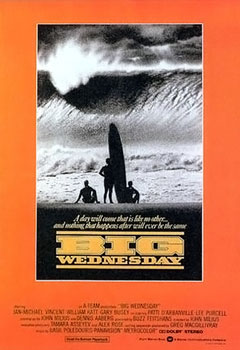
Big Wednesday is a 1978 American coming of age buddy sports comedy-drama film directed by John Milius. Written by Milius and Dennis Aaberg, it is loosely based on their own experiences at Malibu, California. The picture stars Jan-Michael Vincent, William Katt, and Gary Busey as California surfers facing life and the Vietnam War against the backdrop of their love of surfing.
Greg Noll was an American pioneer of big wave surfing and a prominent longboard shaper. Nicknamed "Da Bull" by Phil Edwards in reference to his physique and way of charging down the face of a wave, he was on the U.S. lifeguard team that introduced Malibu boards to Australia around the time of the 1956 Summer Olympics in Melbourne. He produced a "legendary" series of five Search for Surf films.

The beach party film is an American film genre of feature films which were produced and released between 1963 and 1968, created by American International Pictures (AIP), beginning with their surprise hit, Beach Party, in July 1963. With this film, AIP is credited with creating the genre. In addition to the AIP films, several contributions to the genre were produced and released by major and independent studios alike. According to various sources, the genre comprises over 30 films, with the lower-budget AIP films being the most profitable.
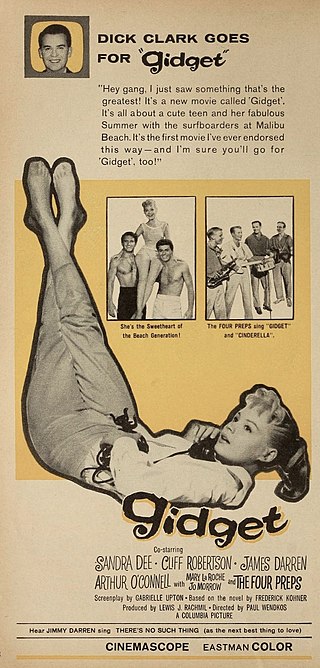
Surf movies fall into three distinct genres:

Surf culture includes the people, language, fashion, and lifestyle surrounding the sport of surfing. The history of surfing began with the ancient Polynesians. That initial culture directly influenced modern surfing, which began to flourish and evolve in the early 20th century, with its popularity peaking during the 1950s and 1960s. It has affected music, fashion, literature, film, art, and youth jargon in popular culture. The number of surfers throughout the world continues to increase as the culture spreads.
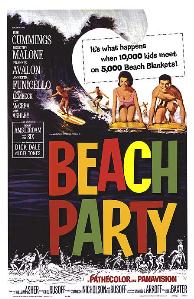
Beach Party is a 1963 American film and the first of seven beach party films from American International Pictures (AIP) aimed at a teen audience. This film is often credited with creating the beach party film genre.
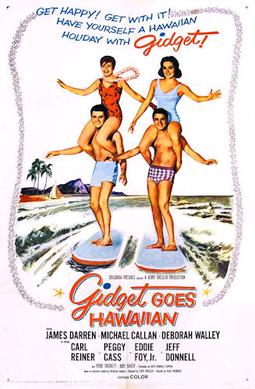
Gidget Goes Hawaiian is a 1961 American romantic comedy musical film starring James Darren, Michael Callan and Deborah Walley. Released by Columbia Pictures, the film is a sequel to the 1959 Sandra Dee beach film vehicle Gidget. Dee was under contract to Universal for the rival series film Tammy Tell Me True (1961) and would not be released to Columbia to reprise her hit role.

Muscle Beach Party is the second of seven beach party films produced by American International Pictures. It stars Frankie Avalon and Annette Funicello and was directed by William Asher, who also directed four other films in this series.

The riding of waves has likely existed since humans began swimming in the ocean. In this sense, bodysurfing is the oldest type of wave-catching. Undoubtedly ancient sailors learned how to ride wave energy on many styles of early boats. Archaeological evidence even suggests that ancient cultures of Peru surfed on reed watercraft for fishing and recreation up to five thousand years ago. However, standing up on what is now called a surfboard is a relatively recent innovation developed by the Polynesians. The influences for modern surfing can be directly traced to the surfers of pre-contact Hawaii.

Wild on the Beach is a 1965 beach party film directed by Maury Dexter and starring Frankie Randall, Sherry Jackson, Gayle Caldwell, and Jackie Miller. It is notable for the musical acts showcased onscreen, being the film debut of Sonny & Cher in particular. It is one of the few films in the genre to be filmed in black and white.

Surf Party is a 1964 beach party film directed by Maury Dexter and starring Bobby Vinton, Patricia Morrow, Jackie DeShannon, and Ken Miller. It was the first direct imitation of AIP's hit Beach Party, which was released six months earlier, and showcased several musical acts onscreen. It is one of the few movies in the genre shot in black and white.

This glossary of surfing includes some of the extensive vocabulary used to describe various aspects of the sport of surfing as described in literature on the subject.[a][b] In some cases terms have spread to a wider cultural use. These terms were originally coined by people who were directly involved in the sport of surfing.

Bikini Beach is a 1964 American teen film directed by William Asher and starring Frankie Avalon and Annette Funicello. The film belongs to the beach party genre of movies, popular in the 1960s. This is the third in the series of seven films produced by American International Pictures (AIP).

Surfing in the United States is a popular hobby in coastal areas, and more recently due to the invention of wave pools, inland regions of the country. It contributes to a lifestyle and culture in which millions participate and which millions more have an interest. USA surfing is the governing body for the sport of surfing in the United States, with surf leagues such as the World Surf League available in the country. Surfing can be traced back to 17th Century Hawaii and has evolved over time into the professional sport it is today, with surfing being included for the first time in the 2020 Summer Olympics in Tokyo.
